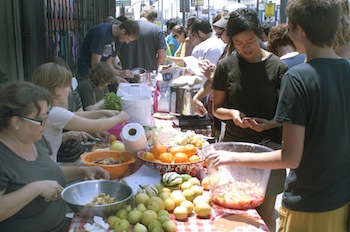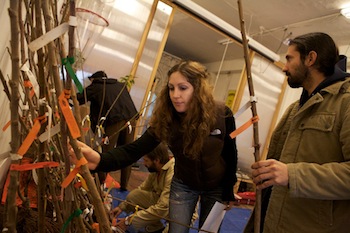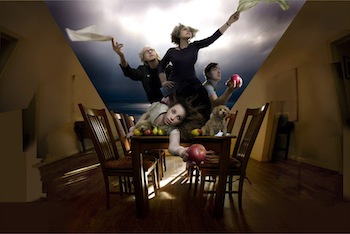Fallen Fruit Collective formed six years ago through a project by artists David Burns, Matias Viegener, and Austin Young for the Journal of Aesthetics and Protest. The trio created a street-by-street diagram of fruit trees growing on or over public property in their Silver Lake neighborhood of Los Angeles. While the city boasts bananas, peaches, avocados, lemons, oranges, kumquats, plums, pomegranates, and other fruits growing year-round, this bounty is not always shared. Mapping “public fruit” was a way to approach food resource and accessibility concerns in urban space. From the beginning, Fallen Fruit urged city officials, urban planning groups, and property owners to plant with the goal of yielding edible goods for the local populace. You might call Burns, Viegener, and Young the locavores of contemporary art.
Next month, Fallen Fruit will launch EATLACMA, a year-long investigation into food, art, culture, and politics at the Los Angeles County Museum of Art. Their ambitious plan consists of an exhibition culled from the museum’s collection; a newly commissioned work; seven curated artist gardens on the museum campus; two fruit tree giveaways; a participatory YouTube project; and Let Them Eat LACMA, a day of public performance and engagement involving over fifty artists and collectives. EATLACMA grew out of Fallen Fruit’s participation in a program at the museum in 2008 (organized by Machine Project), for which they mapped fruit in the permanent collection and designed thematic tours. In a recent interview, Burns explained this way of looking at the history of art:
“When you start organizing painting or history by looking at the subject/object/symbol of fruit, it’s really fascinating the way it collapses art. People put so much importance on the stroke, which is valid, and in what Impressionism [for instance] means, but forget that the reason [an artist] is painting oranges is because they’re colorful. Or you go back a hundred years and Dutch painters are painting them because they’re exotic, expensive, and oranges do not grow in Northern Europe. It’s a luxury item that is only possible because of shipping industries and world trade.”
In EATLACMA, depictions of fruit serve to connect the museum’s holdings in a whole new way and shed light on food in the history of human contact. (Burns informed me that fruit exists in the history of art more than any other food.) But it is living fruit that Burns, Viegener, and Young use to connect people today.
Since 2004, Fallen Fruit’s work has expanded from public fruit maps to include full-on fruit experiences such as collaborative jam making and nighttime fruit tours. Their goal is not to feed people, but to bring them together around food. Participants of Fallen Fruit’s annual fruit tree adoption program are asked to plant their young trees in public space or on the perimeter of private property. Whereas hedges tend to act like fences, fruit trees foster community. The members of Fallen Fruit each recognize a distinct spirit of generosity in every city they’ve been that is abundant with fruit. Young said:
“When we thought of the initial project [for the Journal of Aesthetics and Protest], we had the challenge to come up with an art piece that wasn’t critical, but only posed positive solutions. All of us were really excited when we went around our neighborhood and saw fruit that we could pick. We felt strongly about proposing a project on sharing fruit with your neighbors, and the idea that if you plant just one fruit tree on the perimeter of your property, within five years you’ll be sharing tons of fruit and you’ll permanently change the way someone views your neighborhood. A lot of people have planted fruit trees and it feels like we’re actually making some kind of change in that respect.”
EATLACMA will kick off with two fruit tree giveaways, one at the museum and the other at Watts Towers. These events are intended to signal the start of the growth cycle, as well as the project’s commitment to transforming neighborhoods.
In a concurrent project with the Tijuana art space La Casa Del Túnel, Fallen Fruit will place fruit trees along the US-Mexico border. Fallen Fruit’s gesture in this mostly concrete and increasingly militarized zone draws attention to national issues of privacy and ownership. Manmade boundaries mimic separatist attitudes that can often be traced to the food supply of a region and nourishment of its people. In the entire district of Colonia Federal, there stands a total of 20 trees with only one fruit bearing plant. Fallen Fruit will insert 21 fruit trees into the landscape to “just tip it.” No one can say for sure if fruit in Colonia Federal will one day flourish, but it’s almost certain that Fallen Fruit has already changed the look and feel of the place.
Within the walls of a museum boundaries are clear: signs and guards tell visitors what they can and cannot touch. But how does Fallen Fruit determine what is public, or free for the picking in the open air? Young says, “if you have a tree in your yard and the branches hang over the sidewalk we would call that public fruit. It’s kind of similar to that unspoken law that [says] if your branch hangs over in your neighbor’s yard, your neighbor is allowed to cut the branch off.” When CBS News asked the Los Angeles District Attorney’s office about Fallen Fruit’s work, they replied saying, “it is not illegal to pick fruit in public space.” Burns says, “the footnote on that is there’s no actual definition of what the public is, so there’s no law about public space. Part of what we’re interested in asking is who the public is…So, we’ve chosen to play with fruit, or with our food, as a way to negotiate some of these boundaries.”
EATLACMA is curated by Fallen Fruit Collective and LACMA curator Michele Urton. Click here for the calendar of events.








Pingback: What’s Cookin at the Art21 Blog: A Weekly Index | Art21 Blog
Pingback: Fallen Fruit Collective | Broken City Lab
Pingback: Gastro-Vision: The Best in Food-Art 2010 | Art21 Blog
Pingback: Open Enrollment: From My Institution to Yours | Art21 Blog